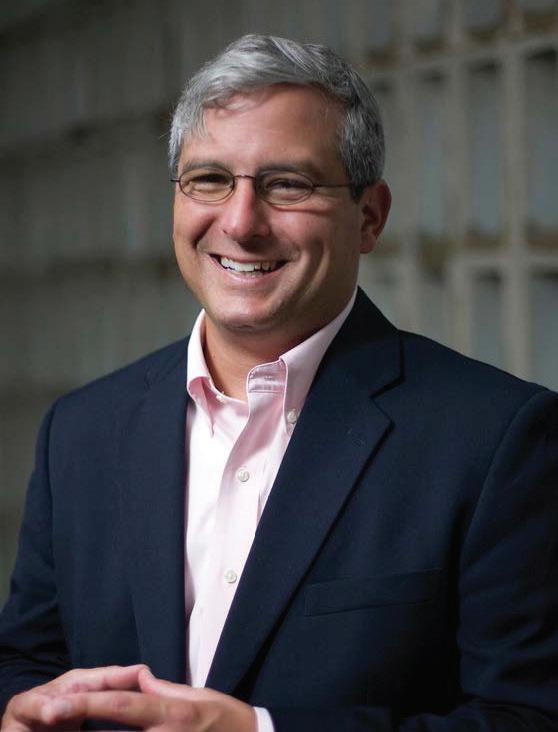
11 minute read
FLEXIBILITY IS EVERYTHING M
ost of the larger campaigns that CHSGa implements integrate both print and digital elements. For example, when the Georgia healthcare provider implements a large outreach campaign for one of its nursing homes, both digital and print strategies are employed.
Kelly Laughlin, CMC, CDMP, VP of Communications, says that both lend themselves to the different audiences CHSGa serves. “It’s important to reach an audience in several different ways. We use billboards, brochures, direct mail pieces and flyers. We also implement a campaign on social media, email and on our websites.”
More than anything, Laughlin says the key to success is not only in having the flexibility to choose what strategy works, but knowing the audience you are trying to reach. While it seems like a simple premise to follow, too many marketers tend to miss the mark.
“Knowing your audience and how best to speak to each one is critical,” Laughlin says. “Having the right message along with the right medium is important. We use digital and print to complement each other. We don’t use the same artwork, but something similar so it creates familiarity and continues to tell the story. On print, we direct them to our digital platforms. On the digital platforms, we provide avenues for them to sign up for our mailing list, which can include both digital and direct mail.”
Laughlin admits that marketers hear the same old song when it comes to using and measuring either campaign strategy. “Measurement is the age-old question and is always a challenge. But with all of the digital tool available, it’s easier than ever to tie our campaigns together with calls to actions, as well as QR codes that can help measure our success. We also look at calls that come in, inquiries, and overall awareness.”
And for those who say that digital is more relevant than print, Laughlin is quick to the draw. “Print marketing will never go away; it’s just how we use it that is changing. It’s an invaluable tool in the marketer’s toolbox.”
In the end, there really is no magic trick. The key for successfully marrying print and digital strategies comes down to knowing your audience and speaking across print and digital channels—was missed.
The salvo is three-fold:
Develop a consistent brand image
Ensure your messages and images used in both print and digital are consistent and reinforce each other. This includes elements such as tone of voice, visual style and messaging.
Use complementary media
Consider using complementary media, such as print ads in magazines or newspapers and digital ads on related websites. This will help reinforce a brand’s message and reach its target audience in multiple ways.
Cross-promote your campaigns
Promote digital campaigns through print ads and vice-versa. This will increase the visibility and awareness of your brand and help create a cohesive message.
Find your target audience, identify your marketing goals, and secure your budget and resources. “A mentor once told me,
‘What can be measured can be optimized,’” Flanagan says. “[Things like a] website needs tracking pixels from paid and social media sites and Google Analytics tags to capture digital traffic. QR codes can be sent to different landing pages to track print ads separately along with unique phone numbers per ad. Understanding your target audience is critical in determining the most effective channels for reaching them.” their language. While print may appeal to an older crowd, digital often speaks to the younger sect. As Laughlin says, “We try to ‘loosen the collar’ a bit with our digital strategy so the conversations are more casual. Our print strategy is a bit more straightforward.”

To drive the point home, the walk-in tub campaign is that example. If your target audience is older (seniors), print advertising may be more effective, while if it is younger (their children), digital advertising may be a better option.
And both strike at the heart of creating engagement.

How To Get More Done With Fewer People

THE TRICK IS IN THE PIVOT. The tactic is something Ray Sheehan has learned all too well to embrace the past few years. As founder of Old City Media, Sheehan created a national sponsorship marketing agency that helps brands connect with target demographics through experiential marketing. The pivot came amid the pandemic, which forced Old City Media—like scores of other companies—to make a series of changes it is still grappling with.
One of those changes hit at the very core of what Sheehan had built the past 20-plus years, namely a team that had a unique ability to bridge the necessary gaps needed to succeed while saving time and money. The Old City Media strategy revolves around the “Crawl – Walk – Run” strategy, which hits its stride once a client sees the full potential of what the agency can do and expands the partnership.
The challenge was filling the holes with the human assets needed to make that equation work. “Coming out of the pandemic, it has been challenging fulfilling those roles with all the talent shortages out there. One area where we have seen huge success is in hiring talented temp workers. A lot of people who lost their jobs created their own business, brand or boutique agencies. Now, you can hire these experts for a trial period.”

The strategy has helped Old City save an immeasurable amount of money in wages and other areas like insurance. Now, Sheehan can hire talent based on the work he needs and manage his cashflow more efficiently. Plus, private contractors are highly motivated on the accountability front and work even more efficiently to renew their contracts.
“Instead of having someone within your organization work on something, it is much more efficient to outsource it to a team of experts,” Sheehan says. “For example, take creative design. While having someone on staff to handle all your creative needs is a nice luxury, it is not always possible. There are plenty of vendors out there who handle this. Or, maybe you need help with marketing, but you need an expert in SEO. Going with a digital marketing agency could provide the exact insight and knowledge you need to grow your business.”
Today, Old City Media is built around strategic partnerships and vendors. In addition, the relationships are a great way to build its network and find referrals. Sheehan says that working with contractors puts you in a better position to negotiate a better deal. You have all the leverage.
Another ally in the battle of shorthandedness is technology. Sheehan recommends finding a CRM that best suits your needs and objectives. This helps immensely with time management and limited resources.
Over the past few years, his Top 5 includes: HubSpot, Zoho, Zendesk Sell, Monday.com and Mailchimp. “Depending on your industry, there are many tools out there to help scale your business. You just need to research which ones make the most sense. Most platforms offer free trials and give you the ability to try before you buy.”
What he said…
In the sometimes hectic world of music marketing, there are times when Adamm Miguest feels like he is washed over in deadlines. There are times when it is not unusual for Rapid Launch Media (RLM) to have 10-plus campaigns going at once for major artists. And there was that time when the CEO only had three employees to jump through all the hoops.
“Yes, we were a little short-staffed,” Miguest says.
To make things even more interesting, RLM was not getting good leads from any of the traditional hiring sites. Thanks to Miguest’s proficiency on social media, he was able to find the right fits, eventually adding four employees to his ever-growing team. “Most companies are afraid to think outside of the box and try new things. That’s one of the reasons I feel like my company has been successful. We are not afraid to think outside of the box.”
His penchant for trying new things is what keeps RLM on the cutting edge of the marketing game. Take its recent embrace of Chat GPT technology, which Miguest says is going to change the game and save immeasurable time for employees and companies.
Recently, a client requested that the Miguest and the RLM team send them a statement of work detailing the tasks it planned for an upcoming marketing campaign. Because a statement of work features a particular style of formatting, the process could have taken a while to do it properly. “I told my employees I’ll try typing in ‘make me a statement of work for X client’ on Chat GPT and see what happens. It worked better than I could have imagined—and in two minutes. I don’t think we had to make any edits.”
In today’s ever-demanding marketing landscape, the fight for time, resources and perfection is real. It is why Miguest believes the best way forward is to stay focused, creative and persistent. “I believe the marketing community can come together and create a more streamlined process in areas like finding employees and using marketing strategies to attract top, potential talent. In the light of these shortages, you have to stay on top of your team. Make sure no one is distracted, and that everyone stays positive and motivated.” Miguest has a saying he likes to think of when the demands of the job hit the wall: “I would rather be busy than bored.” It is the same message he tells his staff. “If we are experiencing a shortage, I tell them that this is the time for us to show why we are the best in the business. The experience also shows that the company is doing well, which creates more opportunities for everyone.”

As Sheehan says, there is a little bit of art, science and common sense when it comes to doing more with less. First, you need to prioritize your top clients. Second, you must develop a pipeline and marketing plan for each client. Based on that plan, you can selfishly allocate your resources based on bandwidth. But the plan is to have a plan. “We’ve all heard it before, ‘People don’t plan to fail; they fail to plan.”
But remember, planning properly is your biggest ally when working with limited assets—an ally that is worth the strategy.
ARE YOU TALKING TO ME?
When Buyers Want To Hear From You
Many B2B sellers assume buyers don’t want or need to talk to them early in the buying process. According to the “Top Performance in Sales Prospecting” report by the RAIN Group Center for Sales Research, they’re wrong. In their own words, here’s what 488 buyers with $4.2 billion in purchasing power said in the survey on when buyers want to engage with them:

When I’m looking for new ideas and possibilities to drive results
When I’m actively looking for a solution to fix what’s broken or solve a problem
When I’m analyzing a situation and its causes
When I’m identifying and evaluating possible providers
After a provider response to my request for a proposal or quote
I don’t want to engage with providers at all during the buying process
Meet Me At The Top
Looking to formulate a better content strategy for 2023? How about 17 of them? Orbit Media Studios loaded up a funnel filled with 17 content formats to help inspire your planning. Check out where your content fits in the funnel.
1. Search-optimized blog posts
2.
— Branding thought leader Christine Gritmon on the importance of B2B marketers to develop their personal brand
Going All In
B2b Marketers Honing In On The Power Of Data
In case you missed it, the digital age of B2B marketing is here. According to eMarketer’s “U.S. B2B Marketing Data Spending Forecast 2023,” marketers should be fleshing out their digital strategies with the right mix of talent and tech, and fine-tuning messaging for the new B2B buyer. Here’s a look at B2B marketing data spend patterns from 2020-2024.


U.S. B2B MARKETING DATA SPENDING, 2020-2024
BILLIONS AND % CHANGE
2020 $3.35 SPENDING CHANGE: 4.0%
2021 $3.50 SPENDING CHANGE: 4.5%
2022 $3.65 SPENDING CHANGE: 4.4%
2023 $3.77 SPENDING CHANGE: 3.2%
2024 $3.91 SPENDING CHANGE: 3.8%
Why is personal branding important?
Personal branding is important because it can help you build trust and connection, look different, establish credibility and authority in a specific industry or area of expertise, and connect with an audience or potential clients/customers in meaningful ways. Trust: In business relationships, the foundation of trust is safety. Safety in business is am I known, heard, valued, important, does my opinion matter? All of these scream personal branding!
Differentiation: Think unique perspective (how you see it), unique education (how you know it), unique experience (how you do it).
Credibility and Authority: A strong personal brand can lead to more (and better) opportunities. It can also be a competitive advantage over others who may not have a strong personal brand. Networking: Think new opportunities, partnerships, and collaborations. You are at the bar. It’s more than just who you know. It’s who knows you and what they know about you.
Career Advancement: Personal branding increases visibility, reputation, and influence, which lead to more opportunities for advancement, promotions, and higher salaries.
What are some common misconceptions about it?
The 5 myths of Personal Branding include:
PB is bragging.
PB equals your social media presence.
PB is only for celebrities.
PB requires you to act differently.
PB is all about appearances.
How can someone identify their unique value proposition and
EMOTIONAL INTELLIGENCE PREDICTS SUCCESS.
DR. COLBY JUBENVILLE
OUR CONVERSATION WITH THE RENOWNED SPEAKER AND AUTHOR.
At his core, Colby B. Jubenville, PhD is a coach who uses the obstacles and challenges people face in search of achievement as “teachable moments” that help make sense of their life, work and relationships. Dr. Jubenville holds an academic appointment as a Professor at Middle Tennessee State University (MTSU) and is the Director of the Center for Student Coaching and Success.
He is the author of two books including “Zebras and Cheetahs: How to Look Different and Stay Agile to Survive the Business Jungle” (Wiley) and “Me: How To Sell Who You Are, What You Do & Why You Matter to the World.” communicate it effectively to their target audience?
Jubenville works in the business community in human capital and believes at the intersection of personal brands and personal relationships is Emotional Intelligence (EI). He was selected by The Nashville Business Journal as a member of its 40 Under 40 class and selected by YP Nashville as its Impact Award Winner, which recognizes top leaders who have made a significant impact on the city’s YP demographic. He is the recipient of the St. Paul’s Episcopal School (Mobile, Alabama) Distinguished Alumni award. Jubenville is a member of the Forbes Councils and publishes content on Forbes.com; and is the host of The Goat Consulting Podcast, which drops weekly on Apple Podcast and YouTube.

A personal brand is made up of Brand Image and Brand Identity. Brand image is the feeling(s) that other people have about you. Brand Identity is made up of your unique perspective, unique education, unique experience. What feelings do you want others to have about you?
What role does emotional intelligence play in building and maintaining a strong personal brand?
At the intersection of personal brands and personal relationships is Emotional Intelligence (EI). Emotional Intelligence is the #1 predictor of performance in the workplace. It can be taught and learned.
Those that have it perform at a higher level than those that don’t. EI starts with self-awareness. Think of it this way: Personal branding starts with selfawareness, a key component of EI!
Can you share some examples of individuals or companies that have successfully leveraged their personal brand to achieve their goals?
Johnny Cash, Gary V., Mr. Rogers, Trader Joe’s, Julie Voss, Golden Goose, Top Golf, and of course, The University of Alabama (football).
How can someone stay authentic and avoid coming across as inauthentic or overly self-promotional when building their personal brand? Double down on you, not someone else.
Your experiences make your story. Your story makes your identity. Your identity shapes your behavior. Your behavior drives your outcome. Write down three stories that are the defining moments of your life. Start there.
What are some common mistakes people make when trying to build their personal brand, and how can they avoid them?
When starting, focus on what your motivation is to create a personal brand. Don’t try to do it all at once. Pick one of the following:
Self-Awareness
Differentiate Yourself
Move Up in Your Career

Build Meaningful Relationships
(Connection)
Recruit and Close
Pitch to Clients
Build Referral
Raise Money (and Friends)
Take Market Share
Create Impact & Competitive Advantage
How can someone measure the success of their personal brand, and what metrics should they track? Easy metrics. Pick one from above. Grow it.
What advice would you give to someone who is just starting to think about building their personal brand?
As Don Shula would say, “Don’t let the start stop you.” Stop thinking about it. Start doing it. It works. Start small.
Try this, “My name is and I specialize in .” People pay more for what you specialize in!



